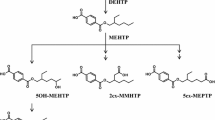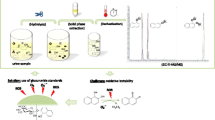Abstract
Excretion of pentachlorophenol-14C in the urine of rats and mice after oral and intraperitoneal administration (10 to 25 mg/kg) was studied. 41 to 43% of the excretion activity was found to be present as unchanged pentachlorophenol. By means of gas chromatography-mass spectrometry, one metabolite was identified as tetrachlorohydroquinone, representing 5 and 24% of the excreted activity in rats and mice, respectively. Conjugation with glucuronic acid could not be demonstrated by enzymatic hydrolysis since tetrachlorohydroquinone was found to be a potent inhibitor of β-glucuronidase, the I50 being 1.6 to 2.0×10−6 M. Boiling the urine with hydrochloric acid was shown to convert all of the excreted activity to pentachlorophenol and tetrachlorohydroquinone, the latter representing 43 and 46% in rats and mice, respectively. Tetrachlorohydroquinone was found in the urine of workers occupationally exposed to pentachlorophenol.
Zusammenfassung
Die Ausscheidung von 14C-Pentachlorphenol im Harn von Ratten und Mäusen wurde nach oraler und intraperitonealer Verabreichung in Dosen von 10 bis 25 mg/kg untersucht. 41 bis 43% der ausgeschiedenen Aktivität waren unverändertes Pentachlorphenol. Mittels kombinierter Gaschromatographie und Massenspektroskopie konnte ein Metabolit, der 5 bzw. 24% der ausgeschiedenen Aktivität bei Ratten bzw. Mäusen ausmacht, als Tetrachlorhydrochinon identifiziert werden. Das Vorhandensein von Glucuronsäure-Konjugaten ließ sich nicht durch enzymatische Hydrolyse nachweisen, da Tetrachlorhydrochinon ein starker β-Glucuronidase-Hemmer (I50 = 1,6 bis 2,0×10−6M) ist. Kochen des Harns mit HCl wandelte die gesamte ausgeschiedene Aktivität in Pentachlorphenol und Tetrachlorhydrochinon um. Davon entfielen 43 (Ratten) bzw. 46% (Mäuse) auf Tetrachlorhydrochinon. Tetrachlorhydrochinon konnte auch im Harn von Arbeitern nachgewiesen werden, die beruflich mit Pentachlorphenol in Kontakt kommen.
Similar content being viewed by others
References
Barthel, W. F., Curleü, A., Trasher, C. L., Sedlak, V. A., Armstrong, R.: Determination of pentaohlorophenol in blood, urine, tissue and clothing. J. AOAC 52, 294–298 (1969)
Betts, J. J., James, S. P., Thorpe, W. V.: The metabolism of pentachloronitrobenzene and 2∶3∶4∶6-tetrachloronitrobenzene and the formation of mercapturic acids in the rabbit. Biochem. J. 61, 611–617 (1955)
Bevenue, A., Wilson, J. R., Potter, E. F., Moon Ki Song: A method for the determination of pentachlorophenol in human urine in picogram quantities. Bull. Environm. Contamin. Toxicol. 1, 257–266 (1966)
Bevenue, A., Beckman, N.: Pentachlorophenol: A discussion of its properties and its occurrence as a residue in human and animal tissues. Residue Reviews 19, 83–134 (1967)
Cranmer, M., Freal, J.: Gas Chromatographic analysis of pentachlorophenol in human urine by formation of alkyl ethers. Life Sciences 9, 121–128 (1970)
Deichmann, W., Machle, W., Kitzmiller, K. V., Thomas, G.: Acute and chronic effects of pentachlorophenol and sodium pentachlorophenate upon experimental animals. J. Pharmacol. exp. Ther. 76, 104–117 (1942)
Dutton, G. J. (Ed.): Glucuronic acid. New York: Academic Press 1966
Elkin, K., Pierrou, L., Ahlborg, U. G., Holmstedt, B., Lindgren, J.-E.: Computer-controlled mass fragmentography with digital signal processing. J. Chromatography 81, 47–55 (1973)
Jacobson, I., Yllner, S.: Metabolism of 14C-pentachlorophenol in the mouse. Acta pharmacol. (Kbh.) 29, 513–524 (1971)
Larsen, R. V., Kirsch, L., Shaw, S. M., Christian, S. E., Born, G. S.: Excretion and tissue distribution of uniformly labelled 14C-pentachlorophenol in rats. J. pharm. Sci. 61, 2004–2006 (1972)
Mills, G. T., Paul, J., Smith, E. E. B.: Studies on β-glucuronidase. 2. The preparation and properties of three ox-spleen β-glucuronidase fractions. Biochem. J. 53, 232–245 (1953)
Rudling, L.: Determination of pentachlorophenol in organic tissues and water. Water Eesearch 4, 533–537 (1970)
Rivers, J.: Gas Chromatographic determination of pentachlorophenol in human blood and urine. Bull. Environm. Contamin. Toxicol. 8, 294–296 (1972)
Sigma Chemical Co., St. Louis, Mo., USA. Data sheet β-glucuronidase type I (1973a)
Sigma Chemical Co., St. Louis, Mo., USA. Data sheet aryl sulfatase type III (1973b)
Author information
Authors and Affiliations
Rights and permissions
About this article
Cite this article
Ahlborg, U.G., Lindgren, J.E. & Mercier, M. Metabolism of pentachlorophenol. Arch. Toxicol. 32, 271–281 (1974). https://doi.org/10.1007/BF00330109
Received:
Issue Date:
DOI: https://doi.org/10.1007/BF00330109




